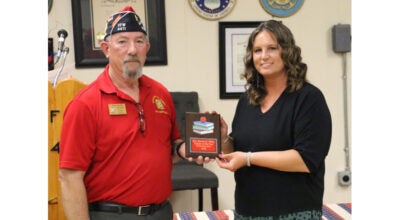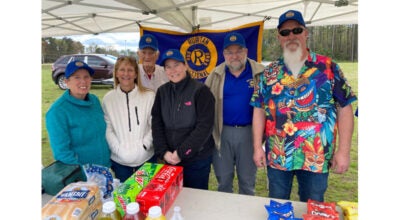Looking Back: Holland-Franklin Highway approved
Published 6:12 pm Thursday, February 18, 2021

- This is the map that Cecil C. Vaughan Jr. drew of the "superhighway" that connects Norfolk with Richmond. -- Submitted | Clyde Parker
|
Getting your Trinity Audio player ready...
|
Feb. 17, 1921
By Clyde Parker
The rivalry for the route of the Holland-Franklin segment of the proposed Norfolk-Richmond superhighway has been settled by State Highway Commissioner George F. Coleman in favor of a route that would take the new roadway to and through Holland — and to and through Carrsville. This had been a matter of considerable dispute between Carrsville and Holland, the people of the latter town desiring the road to go through the main part of their town, instead of, as previously planned, going across one side of it and connecting to points westward that would bypass Carrsville. Numerous delegations have visited Richmond, and public meetings have been held, on behalf of one route or the other. Actually, the “decided-on” route satisfies the concerns and desires of the citizens of both Holland and Carrsville — a major highway going through those towns, instead of around them, is good for local businesses.
The decision in favor of a route that would take the highway through BOTH Holland and Carrsville to Franklin was issued on Jan. 31, 1921, by Mr. Coleman. A formal order to the Clerks of the Court of Nansemond County and Isle of Wight County reads as follows: “The Holland-Franklin segment of the new Norfolk-Richmond Highway will follow, approximately, the present roadway from Suffolk, westward, to a point approximately 1,400 feet within the corporate limits of Holland. At that point, the route will go to the right and strike the present unimproved Holland-Carrsville Road approximately one mile from the Town of Holland. From there, the route will follow, with such upgrading and alignment changes as may be necessary, a direction that will take it through Carrsville and on to Franklin.
It was manifestly impossible for the road to go both ways and the public generally is delighted that it has been definitely settled and that construction of the link between Holland and Franklin can be started within the next few weeks. It is the purpose of the Virginia State Highway Commission to let bids at once for this work. Actual start of construction will begin upon completion of the Franklin-Courtland section of the Norfolk-Richmond Highway. The citizens of Carrsville have generously obligated themselves to loan to the State of Virginia the necessary funds to have the work done, under the terms of the Robinson Act.
With respect to the Franklin-Courtland section of the new highway, on St. Patrick’s Day, Thursday, March 17, a grand celebration will take place in Southampton County — marking the completion and opening to the public of that stretch of the Norfolk-Richmond Highway. The Franklin-Courtland section, which will be of concrete construction, is considered one of the most important links in the overall system.

After his military career, Gen. Cecil Crawley Vaughan Jr. became extremely involved in the development of the Virginia highway system. — Submitted | Clyde Parker
Here, we give a little background on the evolvement of the overall Norfolk-Richmond Highway: When General Cecil Crawley Vaughan Jr. retired from his military career, he returned to Franklin to handle the family banking business — Vaughan & Company Bankers. And, most notably, he became extremely involved in the development of the Virginia highway system. In earlier years, concurrent with his military and banking involvements, General Vaughan had been an active statewide “good-roads” advocate. To date, his most significant roadway accomplishment is the promotion and design of the “superhighway” that connects Norfolk with Richmond — called the “Ridge Route.” Initially a mostly gravel and clay roadway, it later was reinforced with concrete. Starting in Norfolk, the route takes motor vehicle travelers through Portsmouth, Driver, Suffolk, Magnolia, Holland, Carrsville, Fowler’s Crossroads, Franklin, Courtland, Sebrell, Homeville, Hawkinsville, Petersburg and on to Richmond. That route, although not the most direct, geographically, was established based on the more stable land and topography of the areas west of the immediate Norfolk-Portsmouth area.
As stated, General Vaughan is exceedingly involved in the development and modernization of the Virginia highway system. He was actively involved with the establishment of the “Virginia Good Roads Association,” a statewide organization of which he is to become president — in July. In addition, he was instrumental in the organization, in Norfolk, of the Tidewater Automobile Association.
NOTE: The former Norfolk-Richmond “superhighway,” in the present-day, is designated as U. S. Route 58, which emanates out of Virginia Beach, Norfolk and Portsmouth, going westward, to Courtland at which point it connects with State Route 35 North — and on to U.S. Route 301 North.





